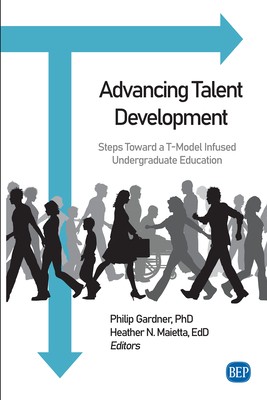
- We will send in 10–14 business days.
- Publisher: Business Expert Press
- ISBN-10: 1951527062
- ISBN-13: 9781951527068
- Format: 15.2 x 22.9 x 1.3 cm, minkšti viršeliai
- Language: English
- SAVE -10% with code: EXTRA
Advancing Talent Development (e-book) (used book) | bookbook.eu
Reviews
Description
Talent development is key to organizations keeping pace with the rapidly changing social and technological developments of today's workplace. Companies are calling for talent that possesses a mastery of discipline and systems, combined with an ability to handle cross-functional, multicultural teams, projects, and assignments. Colleges and universities face challenges in preparing students across all the competency dimensions employers demand.
The T-model configures academic and professional development in a way that allows institutions to provide students with a solid foundation, one built through rich academic and co-curricular experiences that allow them to grow and adapt to the evolving workplace. The T-model comprises five key elements: mastery of academic discipline, system understanding (systems thinking), boundary spanning competencies, interdisciplinary understanding, and a strong sense of self (the ME of the T). In this volume, readers are introduced to the dynamics of the workplace that generate the need for T-professionals, followed by discussion of each of the five key elements of the T-model. Readers are then introduced to and shown how representatives from different segments of higher education infuse the T-model across the curriculum. The book's final section offers insights from industry professionals on the necessity to grow as a T, once a new graduate enters the workforce.
EXTRA 10 % discount with code: EXTRA
The promotion ends in 21d.23:35:00
The discount code is valid when purchasing from 10 €. Discounts do not stack.
- Publisher: Business Expert Press
- ISBN-10: 1951527062
- ISBN-13: 9781951527068
- Format: 15.2 x 22.9 x 1.3 cm, minkšti viršeliai
- Language: English English
Talent development is key to organizations keeping pace with the rapidly changing social and technological developments of today's workplace. Companies are calling for talent that possesses a mastery of discipline and systems, combined with an ability to handle cross-functional, multicultural teams, projects, and assignments. Colleges and universities face challenges in preparing students across all the competency dimensions employers demand.
The T-model configures academic and professional development in a way that allows institutions to provide students with a solid foundation, one built through rich academic and co-curricular experiences that allow them to grow and adapt to the evolving workplace. The T-model comprises five key elements: mastery of academic discipline, system understanding (systems thinking), boundary spanning competencies, interdisciplinary understanding, and a strong sense of self (the ME of the T). In this volume, readers are introduced to the dynamics of the workplace that generate the need for T-professionals, followed by discussion of each of the five key elements of the T-model. Readers are then introduced to and shown how representatives from different segments of higher education infuse the T-model across the curriculum. The book's final section offers insights from industry professionals on the necessity to grow as a T, once a new graduate enters the workforce.


Reviews